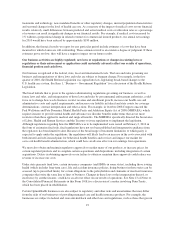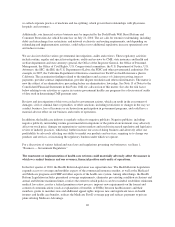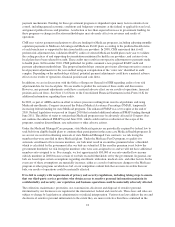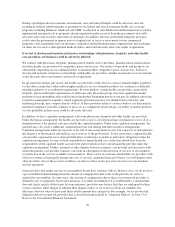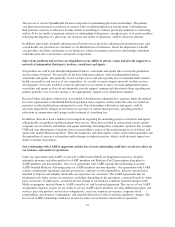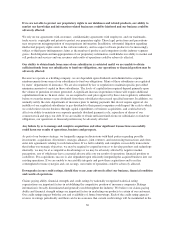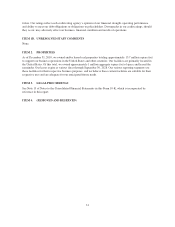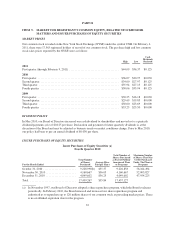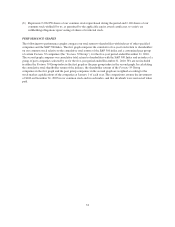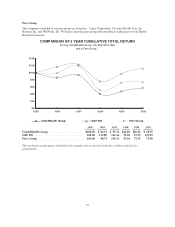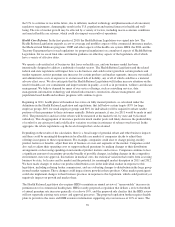United Healthcare 2010 Annual Report Download - page 31
Download and view the complete annual report
Please find page 31 of the 2010 United Healthcare annual report below. You can navigate through the pages in the report by either clicking on the pages listed below, or by using the keyword search tool below to find specific information within the annual report.manner in or the extent to which the Health Reform Legislation is implemented may impact our ability to
maintain the value of our goodwill and other intangible assets in our business. In addition, from time to time we
divest businesses as part of our business strategy, and any such divestiture could result in significant asset
impairment and disposition charges, including those related to goodwill and other intangible assets. Any future
evaluations requiring an impairment of our goodwill and other intangible assets could materially affect our
results of operations and shareholders’ equity in the period in which the impairment occurs. A material decrease
in shareholders’ equity could, in turn, negatively impact our debt ratings or potentially impact our compliance
with existing debt covenants.
Large-scale medical emergencies may result in significant medical costs and may have a material adverse
effect on our business, financial condition and results of operations.
Large-scale medical emergencies can take many forms and can cause widespread illness and death. Such
emergencies could materially and adversely affect the U.S. economy in general and the health care industry
specifically. For example, in the event of a natural disaster, bioterrorism attack, pandemic or other extreme
events, we could face, among other things, significant medical costs and increased use of health care services.
Any such disaster or similar event could have a material adverse effect on our business, financial condition and
results of operations.
If we fail to properly maintain the integrity or availability of our data or to strategically implement new or
upgrade or consolidate existing information systems, or if our technology products do not operate as
intended, our business could be materially adversely affected.
Our ability to adequately price our products and services, to provide effective service to our customers in an
efficient and uninterrupted fashion, and to accurately report our results of operations depends on the integrity of
the data in our information systems. As a result of technology initiatives and recently enacted regulations,
changes in our system platforms and integration of new business acquisitions, we have been consolidating and
integrating the number of systems we operate and have upgraded and expanded our information systems
capabilities. Our information systems require an ongoing commitment of significant resources to maintain,
protect and enhance existing systems and develop new systems to keep pace with continuing changes in
information processing technology, evolving systems and regulatory standards, and changing customer patterns.
If the information we rely upon to run our businesses was found to be inaccurate or unreliable or if we fail to
maintain or protect our information systems and data integrity effectively, we could lose existing customers, have
difficulty attracting new customers, have problems in determining medical cost estimates and establishing
appropriate pricing, have difficulty preventing, detecting and controlling fraud, have disputes with customers,
physicians and other health care professionals, have regulatory sanctions or penalties imposed, have increases in
operating expenses or suffer other adverse consequences. There can be no assurance that our process of
consolidating the number of systems we operate, upgrading and expanding our information systems capabilities,
protecting and enhancing our systems and developing new systems to keep pace with continuing changes in
information processing technology will be successful or that additional systems issues will not arise in the future.
Failure to consolidate and integrate our systems successfully could result in higher than expected costs and
diversion of management’s time and energy, which could materially impact our business, financial condition and
results of operations.
In addition, certain of our businesses sell and install hardware and software products, and these products may
contain unexpected design defects or may encounter unexpected complications during installation or when used
with other technologies utilized by the customer. Connectivity among competing technologies is becoming
increasingly important in the health care industry. A failure of our technology products to operate as intended and
in a seamless fashion with other products could adversely affect our revenues and our results of operations.
29


